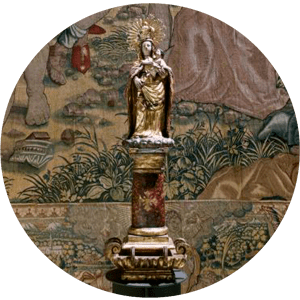We are situated in Episcopal Room promoted by Archbishop Dalmau de Mur in the middle of 15th century. It is one of the most important parts of the late medieval palace and was used as a chapel for bishops, archbishops and royal characters, such as the Catholic Monarchs and Queen Mary of Castilla.
This archbishop was a great Maecenas of arts in a period in which Zaragoza was a melting pot of cultures. This room is a reflection of the wealth in that moment, and the best artists from the Crown of Aragon participated in its creation.
The architectonical design follows flamboyant Gothic style from northern Europe and was master Isembert’s piece of art. Upper zone remains of the original roof are appreciated, made by carved plaster. These remains have been discovered during the building restoration after remaining hidden since 16th century, when Hernando of Aragon, Archbishop and King Ferdinand the Catholic’s grandson, unmade this chapel separating it into different levels.


